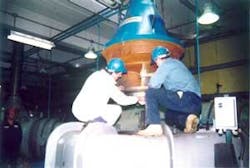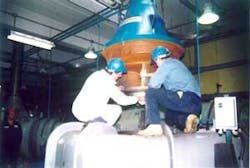Modern Pump Technology Can Help Municipalities Weather Economic Crisis
By Alan Miller
The worldwide economic downturn and the ever-rising cost of energy present pump users with difficult financial situations. Municipalities are particularly hard hit because water delivery systems and wastewater treatment plants must operate even though tax revenues are declining. Changing city demographics must also be considered.
Worldwide, thousands of water treatment facilities are wasting energy by using pumps that are not sized for the current demand. Modern pump and drive technology can improve this mismatch and significant energy savings can be realized.
The U.S. Department of Energy (DOE) estimated that in 1994, pumps in U.S. industrial systems consumed 149 billion kilowatt hours (kWh) of electricity. The water and wastewater segment accounted for 54.7 billion kWh of this total. Clearly, pumping systems consume considerable energy on a worldwide basis.
Given that some energy is wasted due to pump and drive inefficiency, the DOE developed a pumping system assessment tool (PSAT) to enable pump users to assess the efficiency of their pumping systems. This tool can be used to evaluate existing pump systems is available for free at http://www1.eere.energy.gov/industry/bestpractices.
Typical Inefficiencies Found
The following inefficiencies are typically found in pumping systems:
- Pump operating off best efficiency point
- Obsolete variable-speed system
- Excessive pump wear
- Outdated hydraulic design
- Antiquated mechanical design
- Improperly maintained pumps
Addressing the Issues
Considering the age of municipal water/wastewater systems and the number of pumps in the installed base, the potential for energy savings and carbon emission reduction is staggering. Major pump manufacturers have developed huge hydraulic databases, advanced materials, and powerful computer applications which include Computational Fluid Dynamics (CFD), Finite Element Analysis (FEA), and solids-modeling capability which are applied to new pump designs.
These new tools have been used on existing pumps to improve efficiency, reliability, and the mean time between repairs. Modern pump speed controls like variable frequency drives (VFDs) are far more energy efficient than obsolete magnetic couplings, slip-recovery drives, or liquid rheostat systems. VFDs allow station operators to adjust their pump output to the system requirements in cases where a discharge throttle valve was previously used. The application of properly designed modern drive systems can produce energy savings of approximately 25 percent.
Case Studies Operation Off Best-Efficiency Point
A medium-size city in New Hampshire installed end-suction sewage pumps in lift stations located many miles form the central treatment plant. After 20 years of satisfactory operation, the pumps began to fail and increased energy costs were observed.
Flowserve engineers determined that the pump system head was changed by the replacement of old cast-iron force mains with much smoother PVC mains, resulting in the pumps operating off of their characteristic curves. In fact, the pumps were cavitating and the impeller vanes were perforated. New impellers with reduced diameter made the pump performance match the new system and the resulting energy consumption was significantly less than what was experienced before the force-main upgrade.
Obsolete Variable Speed System
A large wastewater treatment facility in New Jersey operated five 300 rpm, 261 kW (350 hp) primary-effluent pumps with variable speed drives. Since VFDs weren’t invented when these pumps were built by Worthington (a pump brand now part of Flowserve), the variable speed system consisted of an 1,800 rpm motor, a parallel axis reduction gear and a hydro-viscous drive. These obsolete drive components were both inefficient and prone to failure.
Flowserve IDP provided all of the new pump components except the 1.07 meter (42 inch) volute casing to renew each unit along with an engineered package of shafting, vertical 300 rpm motors and VFDs. The result was an efficient and reliable pump system.
Because the pump’s large volute casings were rehabilitated and reused, the carbon emissions associated with new casings were avoided.
null
Excessive Pump Wear
In combined sewers, considerable grit is contained in the raw sewage. Abrasive wear results when grit removal does not exist prior to the pumps. In sewage pumps with enclosed impellers, the wear is most significant on the stationary wear ring. Some wear is also experienced on the impeller wear ring, so the result is an ever-increasing wear-ring clearance.
A large wastewater treatment plant in New York operates several horizontal split-case, double-suction pumps in raw sewage service. Flow measurements indicated that the pumps were only providing 80 percent of their design output.
Flowserve was contracted to explain the shortfall of pump capacity. Internal inspection of one pump showed that the impellers were in excellent condition. However, the wear rings showed dramatic wear. The design radial clearance was 0.635 millimeter (0.025 in) while the measured radial clearance (due to ring wear) averaged 15.7 millimeters (0.62 in). Because these are double-suction pumps, the impact of excessive wear ring clearance was doubled. Interestingly, the power consumed by the pumps with excessive wear ring clearance was close to that of pumps with new ring clearance. Pumps with worn wear rings simply pump from discharge back to the suction, resulting in a total waste of energy.
Conclusion
Pump manufacturers can provide municipalities with energy-saving ideas and equipment by using their experience, modern testing and analysis tools. Municipalities may even be able to fund projects with monies provided by electric utilities trying to improve system-energy efficiency. Carbon emissions can be further reduced by improving existing pumps without replacing major castings.
About the Author:
Alan C. Miller is the senior upgrades engineer for the Flowserve Pump Division, Taneytown MD. He has over 35 years experience dealing with turbo machinery, especially pumps. His experience includes; test engineering, product engineering and design, quality assurance and engineering management. Currently he develops and applies upgrades to customer’s existing pumps providing savings in capital and maintenance expense while increasing pump life. Miller has a BSME from the Pennsylvania State University at State College PA.

